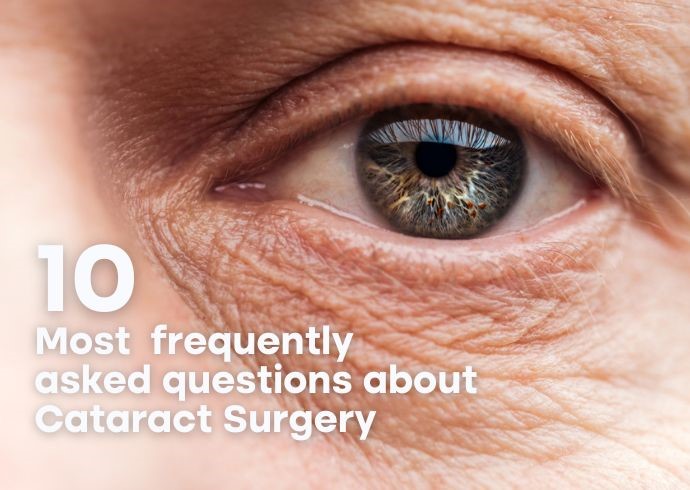10 most frequently asked questions about cataract surgery

The most common questions asked by our patients about cataract surgery.
1. What is a cataract?
A cataract is when the lens of the eye becomes cloudy. As a result, less light can pass through to the back of the eye. It is more common as you get older but can also be caused by UV light, glaucoma, diabetes, smoking, steroid eye drops, and previous eye trauma.
2. How do I know if I have a cataract?
Cataracts can present with a wide variety of symptoms but the most common ones are blurred or faded vision, glare and halos (especially when driving at night), or light sensitivity. It can be picked up by having your eyes examined by an ophthalmologist or optician.
3. Latest cataract treatments.
Cataract surgery has evolved dramatically over the last ten years with advancements both in how the cataracts are broken down as well as the new lens that is implanted in the eye. Cataracts can be broken down with highly efficient ultrasound energy, laser energy, or a combination of both.
Lens technology also offers unrivalled options when it comes to what vision can be achieved after surgery, and your ophthalmologist will spend time with you discussing which are the best lens options for you. This is an extremely important part of your initial consultation as quality of life can really be enhanced by choosing the right lens.
In broad categories, there are lenses to improve distance vision but there is a need for glasses for near and possibly for distance, and these are typically the lenses that you would be offered on the NHS. Premium lenses can reduce astigmatism to further improve the distance vision if there is a co-existing astigmatism.
Premium lenses can also give intermediate vision which is useful for computer work, cooking, walking on uneven surfaces as well as seeing your dashboard when driving. Multifocal premium lenses can give distance, intermediate, and near vision and offer the best opportunity if you wish to be spectacle independent. Not all patients are suitable for multifocal lenses and your consultant will explain this to you in detail during your cataract consultation.
4. How soon can I fly after cataract surgery?
As cataract surgery does not involve expandable gases it is safe to fly within a day or two. We do however recommend our international patients have at least one review after the operation to ensure the eye is settling down as planned.
5. Driving after cataract surgery.
You will generally be seen within a few days or a week after cataract surgery and the safest option is to wait until this first review to ensure that your vision reaches the legal requirements for driving. If you are having one cataract surgery performed at a time and the other eye is within the legal requirements for driving you are safe to drive sooner than this first review.
6. How long does cataract surgery take?
Cataract surgery is normally performed using anaesthetic eye drops and the surgery usually takes ten to fifteen minutes per eye.
7. Cataract surgery recovery time.
With the advancements in cataract surgery, visual recovery is now very quick with patients often seeing very well either later that same day or certainly by the next morning. Cataract surgery does not require stitches in the vast majority of cases and it is important to avoid any strenuous bending or lifting for the first few days after the surgery.
8. Can cataracts be treated with glasses or contact lenses?
Unfortunately, cataracts can only be treated with a small operation to remove the cloudy lens and implant a new lens. Glasses or contact lenses can correct if you are long or short-sighted but do not replace the cloudy lens.
9. Is cataract surgery one of the most common surgeries?
Yes, cataract surgery is one of the most commonly performed, if not the most commonly performed operation in the UK. Each year approximately 400,000 cataract operations are carried out. Cataracts are also the most common cause of sight loss worldwide, but thankfully with treatment, this form of sight loss can be reversed.
10. How many types of cataracts are there?
There are generally three types of cataracts:
- Nuclear cataracts
- Cortical cataracts
- Posterior subcapsular cataracts
Nuclear cataracts are most common as you get older with cortical cataracts more commonly found in diabetic patients. Posterior subcapsular cataracts tend to be found in younger patients and the latter two types of cataracts are the ones that are most recognised for causing significant glare, particularly when driving at night. Nuclear cataracts generally cause a reduction in the distance vision and a fading out of images.
These were the ten most commonly asked questions according to internet searches for our patients. I hope that you found this information useful. Please feel free to share this with friends and family to raise awareness about eye health and particular cataract surgery.
To find out more about the innovative work that we do please have a look at our website www.innovationeyeclinic.co.uk or contact Mr Ratnarajan’s office on 0800 0053335 or info@innovationeyeclinic.co.uk
